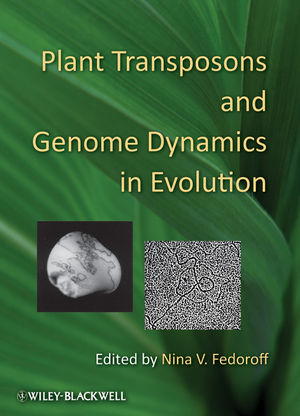
Plant Transposons and Genome Dynamics in Evolution
Wiley-Blackwell (Verlag)
978-0-470-95994-7 (ISBN)
- Titel z.Zt. nicht lieferbar
- Versandkostenfrei
- Auch auf Rechnung
- Artikel merken
This volume is essential reading for anyone working in plant genetics, epigenetics, or evolutionary biology.
Nina V. Fedoroff is Distinguished Professor of Biosciences, King Abdullah University of Science and Technology, and Evan Pugh Professor, Huck Institutes of Life Sciences, Penn State University.
Contributors ix
Foreword xi
David Botstein
Introduction xiii
Nina V. Fedoroff
Chapter 1 The Discovery of Transposition 3
Nina V. Fedoroff
Introduction 3
Studies on Variegation 3
Mutable Genes 5
McClintock’s Studies on Chromosome Breakage 6
Recognition that Ds Transposes 8
Explaining Mutable Genes 9
Molecular Endnote 12
References 12
Chapter 2 A Field Guide to Transposable Elements 15
Alan H. Schulman and Thomas Wicker
The C-value Paradox 15
The Quantity of Transposable Elements Determines Genome Size 16
General Classification Scheme for Transposable Elements 17
Class II Elements 19
Class I: The Non-LTR and LTR Retrotransposons 20
Evolutionary Origins of Transposable Elements 25
Non-autonomous Transposable Elements 28
Transposable Element Demography and Genome Ecology 30
Conclusions: Rehabilitation of Transposable Elements 32
Acknowledgments 34
References 34
Chapter 3 The Mechanism of Ac/Ds Transposition 41
Thomas Peterson and Jianbo Zhang
Transposition of Ac/Ds Elements 41
The Enigmatic Ac Dosage Effect 42
cis and trans Effects on Ac/Ds Transposition 43
Molecular Characterization of Transposable Elements 44
The Excision and Insertion Reactions 45
Formation of Ds from Ac 48
Standard versus Alternative Transposition 48
Sister Chromatid Transposition 48
Reversed-ends Transposition 51
How Does Ds Break Chromosomes? 53
Alternative Transposition, DNA Methylation, and the Sequence of Transposition Reactions 54
Potential Applications of Alternative Transposition 55
Perspective 56
References 56
Chapter 4 McClintock and Epigenetics 61
Nina V. Fedoroff
Introduction 61
Spm-suppressible Alleles 61
Spm-dependent Alleles 64
Cryptic Spm 66
Presetting 66
Molecular Machinery of Epigenetic Regulation 67
Summary 68
References 69
Chapter 5 Molecular Mechanisms of Transposon Epigenetic Regulation 71
Robert A. Martienssen and Vicki L. Chandler
Introduction 71
Chromatin Remodeling, DNA and Histone Modification 73
RNA Interference (RNAi) and RNA-Directed DNA Methylation (RdDM) 75
Heterochromatin Reprogramming and Germ Cell Fate 79
Transgenerational Inheritance of Transposon Silencing 82
Paramutation 83
Conclusions 85
References 85
Chapter 6 Transposons in Plant Gene Regulation 93
Damon R. Lisch
Introduction 93
New Regulatory Functions 94
TE-Induced Down-Regulation 97
Deletions and Rearrangements 98
Suppressible Alleles 100
TEs and Plant Domestication 103
The Dynamic Genome 108
References 110
Chapter 7 Imprinted Gene Expression and the Contribution of Transposable Elements 117
Mary A. Gehring
Why are Genes Imprinted? 118
The Developmental Origin of Endosperm 118
Selection for Imprinted Expression 121
Principles Derived from the First Imprinted Gene 122
Gene Imprinting and Parent-of-Origin Effects on Seed Development 124
What Genes are Imprinted? 124
Epigenome Dynamics during Seed Development 127
Epigenetic Landscape in Vegetative Tissues 127
Cytological Observations of Chromatin in Seeds 129
Epigenomic Profiling in Seeds 130
Mechanisms of Gene Imprinting and the Relation to TEs 132
TEs and Allele-Specific Imprinting 136
Insights from Whole Genome Studies 137
Outstanding Questions 138
References 138
Chapter 8 Transposons and Gene Creation 143
Hugo K. Dooner and Clifford F. Weil
Introduction 143
Capture of Gene Fragments by TEs and Formation of Chimeric Genes 144
Co-Option of a TE Gene by the Host 148
Fusion of TE and Host Genes 150
Alterations of Host Gene Sequences by TE Excisions 151
Alterations of Host Coding Sequences by TE Insertions 152
Acquisition by Host Genes of New Regulatory Sequences from TEs 153
Interaction of TEs with Target Gene mRNA Splicing and Structure 155
Reshuffling of Host Sequences by Alternative Transpositions 156
Conclusion 158
References 158
Chapter 9 Transposons in Plant Speciation 165
Avraham A. Levy
Introduction 165
Genetic Models of Speciation 165
Speciation – a Gradual or a Rapid Process? 166
Speciation Through Accumulation of Mutations 166
DNA Cut-and-Paste TEs and Speciation 167
Copy-and-Paste TEs and Speciation 168
TE-Mediated Speciation – a Likely Scenario? 169
Plant Speciation Through Hybridization and Allopolyploidization 169
Induction of Transposition upon Hybridization and Polyploidization 170
Epigenetic Alteration of TEs upon Hybridization and Polyploidization 170
Transcriptional Activation of TEs upon Hybridization and Polyploidization 171
Alterations in Small RNAs upon Hybridization and Polyploidization 171
A Mechanistic Model for Responses to Genome Shock 172
Dysregulation of Gene Expression by Novel Interactions Between Regulatory Factors 173
Altered Protein Complexes 174
Why TEs Become Activated when Cellular Processes are Dysregulated 174
Conclusions 175
Acknowledgments 176
References 176
Chapter 10 Transposons, Genomic Shock, and Genome Evolution 181
Nina V. Fedoroff and Jeffrey L. Bennetzen
How Transposons Came to be Called “Selfish” DNA 181
The “Selfish DNA” Label Stuck to Transposons 182
Transposons Coevolved with Eukarotic Genomes 182
Sequence Duplication: The Real Innovation 183
The Facilitator: Epigenetic Control of Homologous Recombination 183
Epigenetic Mechanisms, Duplication and Genome Evolution 185
Plant Genome Organization: Gene Islands in a Sea of Repetitive DNA 186
Transposon Neighborhoods and Insertion Site Selection 187
Genome Evolution: Colinearity and Its Erosion 189
Genome Contraction and Divergence of Intergenic Sequences 191
Transposases Sculpt Genomes 192
Small Regulatory RNAs from Transposons 193
Genome Shocks 194
Genome Evolvability 195
References 196
Index 203
| Erscheint lt. Verlag | 15.4.2013 |
|---|---|
| Verlagsort | Hoboken |
| Sprache | englisch |
| Maße | 178 x 250 mm |
| Gewicht | 603 g |
| Themenwelt | Informatik ► Weitere Themen ► Bioinformatik |
| Naturwissenschaften ► Biologie ► Botanik | |
| Naturwissenschaften ► Biologie ► Genetik / Molekularbiologie | |
| ISBN-10 | 0-470-95994-0 / 0470959940 |
| ISBN-13 | 978-0-470-95994-7 / 9780470959947 |
| Zustand | Neuware |
| Haben Sie eine Frage zum Produkt? |
aus dem Bereich


